Mary F. Burns
Author’s End Notes
Teesside University Post-Graduate Conference
31 March 2023
“Ethics, Literature, Culture”
Good morning, good afternoon and good evening to you all. I am honored to be here to provide some End Notes for this brilliant conference. I am especially grateful to Suzy Corrigan for extending the invitation to speak to you, and to the other Committee members, Rebecca, Edris, Danai, and Annie, for a well-organized conference.
TITLE SLIDE 1: “You Can’t Do That! Our Fascination with Breaking the Rules”.
The papers we’ve heard and discussed today present us with OUTSIDERS, with people who have been cast as THE OTHER, whether they’re gender fluid, mixed race, anarchists, feminists, soldier-rebels, non-conformists of all kinds. These are people who THREATEN the given order, who REJECT and ARE REJECTED by a given culture. People who make their own culture. People who break the rules.
We break rules because we see a pinprick of light where we thought there was only sameness and darkness, because we see that something new and different and more colorful, more meaningful, more true, could be experienced, and we want that. I’m not talking about breaking rules like murdering people or stealing money or breaking into a jewelry store, I’m talking about rules that bind your imagination, that curtail your heart’s desires, that keep you from reaching out and saying yes to new things, new experiences, rules that make you fearful and cautious and paralyzed.
With these thoughts as a guideline, let’s take a look at some ideas and some approaches to understanding Ethics, Literature and Culture in the light of how and why we human beings break the rules.
SLIDE 2: Here are some examples of what people through the ages say about rules: The most common and often heard:
- Rules are made to be broken.
- CLICK Unheard-of combinations of circumstances demand unheard-of rules.
- CLICK Learn the rules like a professional so you can break them like an artist.
- CLICK Move fast and break things. [not necessarily endorsing that one!]
SLIDE 3: For every rule, there is a rule-breaker. Let’s look at some famous rule breakers:
- CLICK Prometheus – With a name that may mean “Forethought” (or possibly, fire-thief), Prometheus saw into a future where humankind would be much better off if they had some tools – primarily fire, which he stole from the gods, and which eventually came to signify all of technology and scientific knowledge.
- CLICK Pandora — The gods were so angry with Prometheus, that they swore they’d get even and punish mankind by giving them the gift of Pandora–the first woman, created by Hephaestus and endowed with all sorts of charms, deceptions, wiles and even speech. Along with Pandora came that damn box, which she opened even though she wasn’t supposed to.
These two mythological people broke rules. Let’s consider their motives. Prometheus thought Zeus was unfair in not allowing humans to have fire—he knew it was a beneficial tool, and would help them do many things, like staying warm or cooking a hot meal. He was motivated by wanting to help others.
Pandora, on the other hand, was rather mischievous—she really just wanted to know what was inside the box, and you get the sense that she was annoyed that she was told not to look, and did it from pique and not caring very much what the consequences were, like a bratty teenager. Her motivation was self-gratification, wanting to have her own way, not wanting to be told what to do.
And of course, there were consequences of breaking the rules: CLICK
- CLICK Prometheus was chained to a rock, and an eagle (emblem of Zeus) devoured his liver every day, and it grew back every night; he endured this punishment until Herakles came and freed him.
- CLICK Pandora couldn’t resist opening the box, thereby letting loose all the evils that humankind suffer from: illness, poverty, guilt, violence, war—leaving only a little glow of “HOPE” at the bottom of the box.
It’s interesting to note the difference between the motivation and the punishment in these Greek myths. Prometheus broke the rule in order to provide a benefit for humankind, and he alone was punished, and was ultimately rescued. Pandora, on the other hand, broke the rule out of selfish wilfulness, and the entire world suffered because of it. These are two eternally present motivating human feelings: altruism and selfishness.
SLIDE 4: CLICK Let’s look at another story to explore another instance of rule-breaking—one of the most famous couples ever, Adam & Eve. Their notorious rule-breaking has been the subject of hundreds of books, poems, essays and religious texts for several thousand years—which is pretty amazing for an event that never actually happened. So what was the point of this story? And where did it come from?
SLIDE 5: The Garden of Eden is literally the CULTURE in which Eve and Adam live. A CULTURE, at its most basic, or even shall we say, biological, is a medium in which things GROW—it provides the sustenance, the nourishment, the material which brings things to life.
The ETHICS, or Rules, of Eden are simple—‘be fruitful and multiply’, ‘take care of the animals’, ‘cultivate the garden’ and ‘don’t eat from the Tree of the Knowledge of Good and Evil.”
SLIDE 6: That’s the rule that Eve chose to break. Here’s my rendition of how the whole snake incident went down, with only minor deviations from the text:
- CLICK The Rule: “Thou shalt not eat of the fruit of the tree in the center of the garden. If you do, surely you will die.” –Almighty God
- CLICK Snake: “Did God say you can’t eat ANY fruit from ANY of the trees?”
- CLICK Eve: “No, just the one, but we’re not supposed to even touch it, or we will die.”
- CLICK Snake: “God only said that because if you eat that fruit, you will be as gods yourselves, having knowledge of good and evil.”
- CLICK Eve: “Cool.”
SLIDE 7: CLICK Eve knows the Ethics, she has heard the Rule, and she has heard the consequences (although one wonders if she really knows what that means) and she chooses not only to not follow the Rule, but she adds to it, in a way makes it more restrictive—and then still CLICK chooses to transgress—cross the line. Why does she do this? And then she offers it to Adam, and he breaks the rule too. Why does he do it?
- Eve – the feminine counterpart of Adam – desires knowledge –in the text, she sees that the Tree is “beautiful to look upon” and the taste is “sweet” – here, specifically, the Knowledge of Good and Evil, which is (apparently) a key element of being ‘like gods’. She is not, as religious teachings have always told us, weak, sinful, or gullible. She knows what she’s doing.
- Adam – the masculine counterpart of Eve – listens and chooses to agree and accept as well. He is exercising his free will, and chooses to break the rule too. He too, desires knowledge. He is not, as Milton would have it in Paradise Lost, uxorious—too blindly in love with the woman to deny or reject her; he chooses to know, along with her.
CLICK CLICK The consequences, of course, are that they have to leave the Garden Culture behind, as well as the Ethos of the Garden, and start their own sets of rules that guide their behavior, and start a new Culture, one separate from the Garden.
SLIDE 8: The Book of Genesis – a work of literature – is metaphorical speech about what it means to become a human being: awareness, self-consciousness, choice, change, adaptation, creativity, responsibility. Even in the very act of creating the human being, God is described as creating “them male and female” in a single body—and later bringing Eve forth as a separate being from that first body, but both beings share the same origin. Perhaps there is a necessity, or at least a great benefit, in being two different consciousnesses in the same being – self and other – that leads to the all-important steps of questioning one’s existence, questioning the rules, defying the culture that surrounds you.
SLIDE 9: Literature is Metaphor. All writing is, in fact, metaphor, even non-fiction. Our writings are the mirrors of what the Greeks called The Real Things. Socrates talked about it this way: There is Mythos and there is Logos. They are, in essence, two ways of being in the world, and they are worlds in themselves. The Mythos is the world of people who live inside a common consciousness, who follow a set of rules that are based on a common understanding of how the world works—in ancient times, explanations came in the form of gods, demons, magic. These folks generally do not question the given order, or if they do, it’s just youthful folly and they quickly settle down. But this is where the Human Story comes from: the myths, the legends, heroes and gods, magic and sorcery.
The Logos, on the other hand, is a world of people who, for various reasons, do not feel comfortable in the world of the Mythos—they always seem to be observing it from the outside, as if they are not really part of it; they can’t immerse themselves in the Mythos and feel like they belong. This lack of belonging makes them different, makes them see things differently, makes them act differently. They are not in touch (literally) with the primary things, like the people in the mythos are. So that makes them strive always to re-create a world of Primary Things through secondary means: words, paint, sculpture, dance, music, inventions—in order to explore and explain the world differently. Neither one is necessarily better than the other, they just ARE. They complement each other, they need each other. Both of them separately, and together, are ways to being human.
SLIDE 10: Literature is the language of the Logos—literally the Word. Words are the pieces of what makes a metaphor. The Logos describes us human beings and our worlds to ourselves, using these sounds or written symbols we call words. It is not the thing itself—it is a metaphor—a carrying-over, a transferring, of a real thing into another thing. And sometimes, the only way to show what a real thing is, is to break a rule about that thing and bring attention to a new or different real thing.
Literature presents our own story to us—the story of being human. The best stories are those which show what happens when you break the rules – it’s not always pretty, but it is always human. Literature is the continual attempt to describe HOW we become human, WHAT that means, WHY we do what we do – no matter what culture we come from or to what ethics we subscribe.
SLIDE 11: There are many ways to break the rules in real life – but when you’re writing fiction or even non-fiction, there are mainly two ways to break the rules: Structure and Content.
Here are Ssme famous examples of breaking rules in structure James Joyce, Virginia Woolf, T.S.Eliot e e cummings; Italo Calvino, V.M. Straka. These authors, among others, dropped or ignored the rules of grammar, of how to form a sentence, of what a ‘chapter’ means.
SLIDE 12: Structure – Joyce (and many other Irish authors) remade English, molding the language of the ruling elite into something charmingly subversive, an unstable compound of familiar and foreign. Joyce writes pages of words without any punctuation or breaks, trying to depict the stream of conscious, and unconscious, thinking as people walk through a city or their house, playing with forbidden thoughts about sex and murder, barely articulated, a word here, a broken phrase there. Virginia Wollf, in particular, tried to imitate in writing the thoughts of a person going mad, as she felt herself doing at different times in her life, in addition to depicting the way one’s mind moves along seamlessly from one thought to the next, distracted, focused, drifting.
SLIDE 13: Italo Calvino, in his “If On a Winter’s Night A Traveler” stops writing a story in the middle of it, then starts the next chapter with a different story, then another one with the same characters but in a different time period. He sets up expectations and then deliberately crashes them, does not satisfy your curiosity, does not give you what you wanted—but you get something else from that disruption—a way to see connection in disconnection.
CLICK Straka’s Ship of Theseus included actual post cards, letters, newspaper clippings, greeting cards in the novel, inserted into the pages at strategic points for the reader to consider, along with the rest of the story, and the printed pages are filled with what look like hand-written notes, from the two main characters of the story, who are sharing the book and write to each other. Their notes form an entirely different story from the one that is presented in the actual printed words on the page. CLICK It is an ingenious blending of formats and ways of communicating; he attempts to bring a real life story, in present time, to the suspended, historical time of the printed story, and connect them.
These authors knew they were breaking rules and creating new structures—and of course, they had to know what those rules were to begin with—but more importantly, is WHY would they want to do it differently? I leave it to you to work on the answers.
SLIDE 14: Content – After STRUCTURE, you can break rules with CONTENT.
CLICK From the earliest times, certain activities have been taboo, forbidden in “most” societies, and certainly in modern civilizations of the last two millenia or so: incest, cannabilism, human sacrifice are three examples. CLICK We are all familiar with the phrases “we don’t do that in civilized society” or “we don’t say such things at the dinner table”, or “in mixed company”, or “in front of the children.” CLICK And we all pretty much grow up knowing what those forbidden things are. If you want to break taboos, and talk about ‘hidden things’, the important question to ask, just like breaking a rule of Structure, is WHY. “Shock Value” can be important, but it can also just be a shallow trick, with no meaning.
SLIDE 15: From the presentations of the post-grad students we have heard today, there are many examples of the content-related rule-breaking that I’m alluding to:
Rebecca showing how suburban houses, haunted or otherwise, are metaphors for oppression and modern-day witchhunts.
Danai’s taking on the taboo-topic of “The Mulatto” in reference to black and African American identity;
Annie’s and Sibohan’s examples of cross-dressing and non-conformity to feminine ideals, what is ugly and what is beautiful and how it relates to Culture and Power;
Suzy’s tackling of the notion of The Genius, and how society has widely differing values regarding Men and Women who might be called ‘genius’ or ‘mad’, respectively, for the same brilliance.
Edris’s discussion of the challenges to the American myth of the Glory of War and the Soldier-Hero, revealing the true cost of war and sacrifice.
Henry’s novel approach to women’s identities based on regional or geographical setting and cultures;
And Catherine’s exploration of the racial stereotyping in Twilight, which is a very challenge to the TV-entertainment industry itself about this very popular program.
These are stories about people breaking the rules; and authors exploring why that happens, what it means, how we can understand it.
Human beings dare to step over the line, because of something within them that yearns to be more, or to be something else, or to belong where they have been rejected or cast out. Many things motivate us as human beings to break the rules, and the same goes for when you’re writing literature. The motivation is very important, both for plausability and for responsibility. But you should be clear about your motivation—it will help clarify your objective in writing your book, your essay, your poetry.
SLIDE 16: In ending, I invite you to consider these quotes about METAPHOR for a few moments—one is a challenge, one is a warning.
And I’ll leave you with this thought: Understanding the metaphorical nature of LITERATURE is essential for understanding CULTURE and ETHICS—and why rules are made to be broken.
END SLIDE 17: Thank you so very much. I’m happy to take questions or hear comments, now or by email at any time. www.maryfburns.com maryfburns@att.net
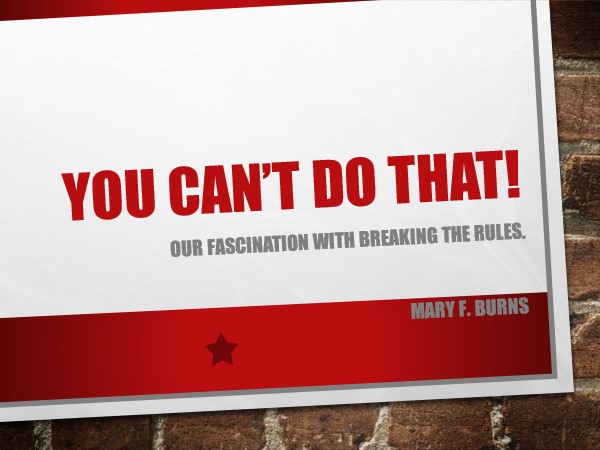
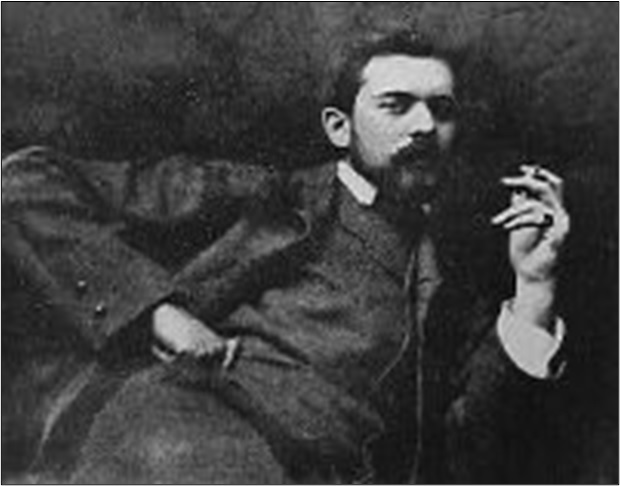
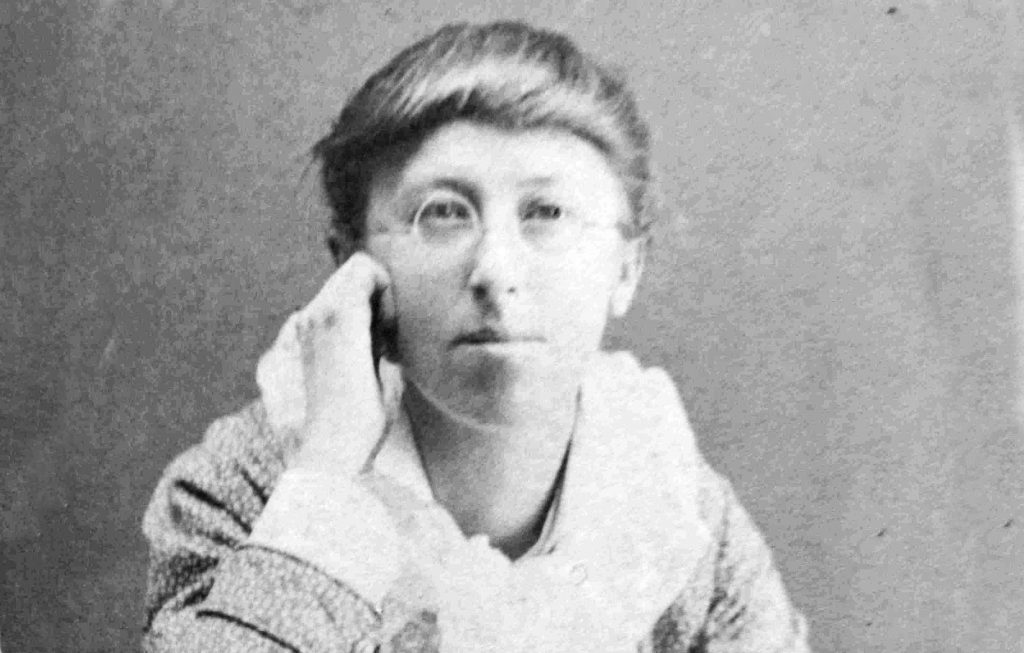
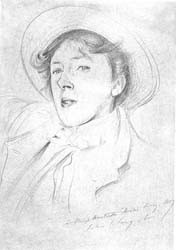
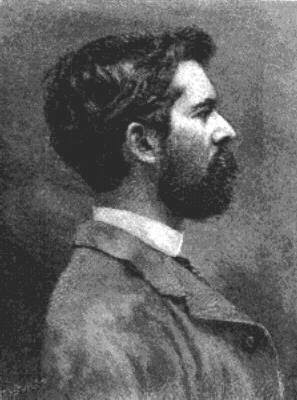
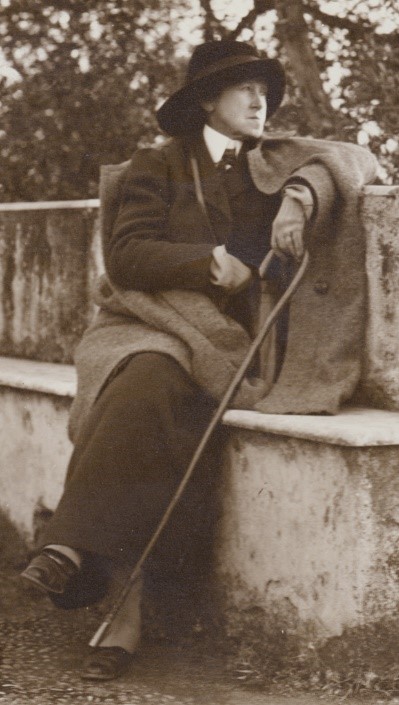

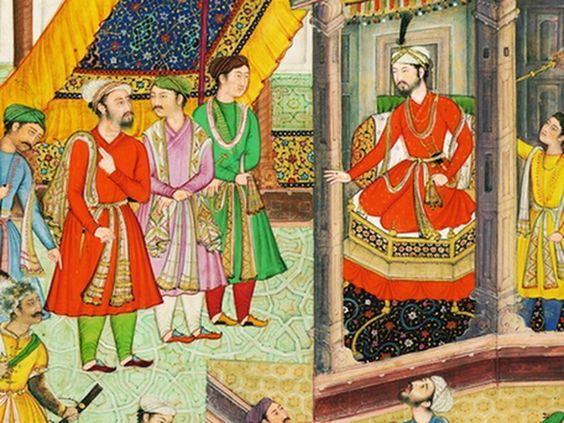

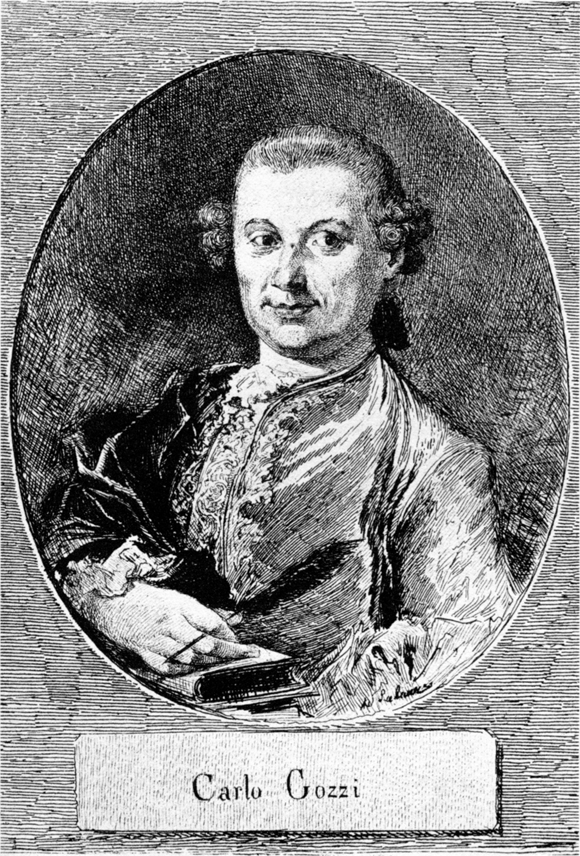


 Why I wrote “J”
Why I wrote “J”